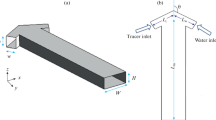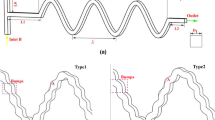Abstract
The necessity of microscale mixing processes has been tremendously increasing in most of the microsize chemical and biochemical devices during recent years, particularly in the design of lab-on-a-chip and micrototal analysis systems. Different approaches were implemented in the available micromixers in the literature for improving the mixing performance. Due to the absence of any external source, mixing by utilizing passive mixing techniques is more economical. In curvilinear microchannels, which offer effective passive mixing, chaotic advection results in continuous radial perforation of inter-diffusion layer between the fluid streams due to the transverse secondary flows. In this study, the effects of Dean vortices and secondary flows were investigated in asymmetrical polydimethylsiloxane curvilinear rectangular microchannels, which were fabricated by one-step lithography process and had repeated S-shape patterns with a curvature of 280° along the channel. Moreover, the effect of asymmetry was assessed by comparing the mixing results with symmetrical microchannels. Mixing performance was analyzed by using NaOH and phenolphthalein solutions as mixing fluids, which entered from the channel inlets. According to the results, the significant effects of stretching and contracting motion of Dean vortices revealed themselves above a certain Dean number value, thereby making the asymmetrical microchannel outperform the symmetrical channel in the mixing performance. Below this threshold, the symmetrical microchannel was observed to be superior to the asymmetrical microchannel.










Similar content being viewed by others
Abbreviations
- \(D_{\text{h}}\) :
-
Hydraulic diameter (m)
- \(I\) :
-
Pixel intensity (–)
- \(K\) :
-
Dean number (–)
- \({\text{MI}}\) :
-
Mixing index (–)
- \(R\) :
-
Flow path radius (m)
- \(Re\) :
-
Reynolds number (–)
- \(u\) :
-
Characteristic velocity (m/s)
- \(U_{\text{f}}\) :
-
Mean fluid velocity (m/s)
- \(\delta\) :
-
Curvature ratio (–)
- \(\rho\) :
-
Density (kg/m3)
- \(\mu\) :
-
Dynamic viscosity (kg/ms)
References
Afzal A, Kim KY (2012) Passive split and recombination micromixer with convergent-divergent walls. Chem Eng J 203:182–192. doi:10.1016/j.cej.2012.06.111
Alam A, Afzal A, Kim KY (2014) Mixing performance of a planar micromixer with circular obstructions in a curved microchannel. Chem Eng Res Des 92:423–434. doi:10.1016/j.cherd.2013.09.008
Aubin J, Fletcher DF, Xuereb C (2005) Design of micromixers using CFD modelling. Chem Eng Sci 60:2503–2516. doi:10.1016/j.ces.2004.11.043
Beebe DJ, Mensing GA, Walker GM (2002) Physics and applications of microfluidics in biology. Annu Rev Biomed Eng 4:261–286. doi:10.1146/annurev.bioeng.4.112601.125916
Cha J, Kim J, Ryu S-K et al (2006) A highly efficient 3D micromixer using soft PDMS bonding. J Micromech Microeng 16:1778–1782. doi:10.1088/0960-1317/16/9/004
Chen JJ, Chen CH, Shie SR (2011a) Optimal designs of staggered dean vortex micromixers. Int J Mol Sci 12:3500–3524. doi:10.3390/ijms12063500
Chen YT, Fang WF, Liu YC, Yang JT (2011b) Analysis of chaos and FRET reaction in split-and-recombine microreactors. Microfluid Nanofluidics 11:339–352. doi:10.1007/s10404-011-0803-8
Cook KJ (2013) Mixing evaluation of a passive scaled-up serpentine micromixer with slanted grooves. J Fluids Eng 135:81102. doi:10.1115/1.4024146
DeMello AJ (2006) Control and detection of chemical reactions in microfluidic systems. Nature 442:394–402. doi:10.1038/nature05062
Fan L-L, Zhu X-L, Zhao H et al (2017) Rapid microfluidic mixer utilizing sharp corner structures. Microfluid Nanofluidics 21:36. doi:10.1007/s10404-017-1874-y
Gallé N, Steinberg V (2016) On-chip encapsulation via chaotic mixing. Microfluid Nanofluidics 20:1–10. doi:10.1007/s10404-016-1820-4
Gobby D, Angeli P, Gavriilidis A (2001) Mixing characteristics of T-type microfluidic mixers. J Micromech Microeng 11:126–132. doi:10.1088/0960-1317/11/2/307
Hardt S, Drese KS, Hessel V, Schönfeld F (2005) Passive micromixers for applications in the microreactor and µTAS fields. Microfluid Nanofluidics 1:108–118. doi:10.1007/s10404-004-0029-0
Hong C-C, Choi J-W, Ahn CH (2004) A novel in-plane passive microfluidic mixer with modified Tesla structures. Lab Chip 4:109–113. doi:10.1039/B305892A
Hosokawa K, Fujii T, Endo I (1999) Droplet-based nano/picoliter mixer using hydrophobic microcapillary vent. In: IEEE micro electro mechanical systems, pp 388–393
Jeong GS, Chung S, Kim C-B, Lee S-H (2010) Applications of micromixing technology. Analyst 135:460–473. doi:10.1039/b921430e
Jiang F, Drese KS, Hardt S et al (2004) Helical flows and chaotic mixing in curved micro channels. AIChE J 50:2297–2305. doi:10.1002/aic.10188
Kang TG, Singh MK, Kwon TH, Anderson PD (2008) Chaotic mixing using periodic and aperiodic sequences of mixing protocols in a micromixer. Microfluid Nanofluidics 4:589–599. doi:10.1007/s10404-007-0206-z
Kang TG, Singh MK, Anderson PD, Meijer HEH (2009) A chaotic serpentine mixer efficient in the creeping flow regime: from design concept to optimization. Microfluid Nanofluidics 7:783–794. doi:10.1007/s10404-009-0437-2
Kim DS, Lee IH, Kwon TH, Cho D-W (2004) A barrier embedded Kenics micromixer. J Micromech Microeng 14:1294–1301. doi:10.1088/0960-1317/14/10/002
Koch M, Witt H, Evans GRA, Brunnschweiler A (1999) Improved characterisation technique for micromixers. J Micromech Microeng 9(2):156. doi:10.1088/0960-1317/9/2/312
Kockmann N, Kiefer T, Engler M, Woias P (2006) Convective mixing and chemical reactions in microchannels with high flow rates. Sens Actuators B Chem 117:495–508. doi:10.1016/j.snb.2006.01.004
Lee CY, Wang WT, Liu CC, Fu LM (2016) Passive mixers in microfluidic systems: a review. Chem Eng J 288:146–160. doi:10.1016/j.cej.2015.10.122
Liu C, Ling Z, Lian K et al (2006) An injection micromixer fabricated by improved SU-8 processing for biochemical microfluidic systems. In: Papautsky I, Wang W (eds) Spie. San Jose, CA, pp 1–7
Livak-Dahl E, Sinn I, Burns M (2011) Microfluidic chemical analysis systems. Annu Rev Chem Biomol Eng 2:325–353. doi:10.1146/annurev-chembioeng-061010-114215
Marques MPC, Fernandes P (2011) Microfluidic devices: useful tools for bioprocess intensification. Molecules 16:8368–8401. doi:10.3390/molecules16108368
Mengeaud V, Josserand J, Girault HH (2002) Mixing processes in a zigzag microchannel: finite element simulations and optical study. Anal Chem 74:4279–4286. doi:10.1021/ac025642e
Nguyen N-T, Wu Z (2005) Micromixers—a review. J Micromech Microeng 15:R1–R16. doi:10.1088/0960-1317/15/2/R01
Park JM, Kim DS, Kang TG, Kwon TH (2008) Improved serpentine laminating micromixer with enhanced local advection. Microfluid Nanofluidics 4:513–523. doi:10.1007/s10404-007-0208-x
Schwesinger N, Frank T, Wurmus H (1999) A modular microfluid system with an integrated micromixer. J Micromech Microeng 6:99–102. doi:10.1088/0960-1317/6/1/023
Singh MK, Kang TG, Meijer HEH, Anderson PD (2008) The mapping method as a toolbox to analyze, design, and optimize micromixers. Microfluid Nanofluidics 5:313–325. doi:10.1007/s10404-007-0251-7
Stroock AD, McGraw GJ (2004) Investigation of the staggered herringbone mixer with a simple analytical model. Philos Trans R Soc Lond A Math Phys Eng Sci 362:971–986. doi:10.1098/rsta.2003.1357
Sudarsan AP, Ugaz VM (2006) Multivortex micromixing. In: Proceedings of the National Academy of Sciences of the United States of America, pp 7228–7233
Tofteberg T, Skolimowski M, Andreassen E, Geschke O (2010) A novel passive micromixer: lamination in a planar channel system. Microfluid Nanofluidics 8:209–215. doi:10.1007/s10404-009-0456-z
Tung KY, Yang JT (2008) Analysis of a chaotic micromixer by novel methods of particle tracking and FRET. Microfluid Nanofluidics 5:749–759. doi:10.1007/s10404-008-0287-3
Voldman J, Gray ML, Schmidt MA (2000) Integrated liquid mixer/valve. J Microelectromech Syst 9:295–302. doi:10.1109/84.870054
Ward K, Fan ZH (2015) Mixing in microfluidic devices and enhancement methods. J Micromech Microeng 25:94001. doi:10.1088/0960-1317/25/9/094001
Xia HM, Wan SYM, Shu C, Chew YT (2005) Chaotic micromixers using two-layer crossing channels to exhibit fast mixing at low Reynolds numbers. Lab Chip 5:748–755. doi:10.1039/b502031j
Xia HM, Shu C, Wan SYM, Chew YT (2006) Influence of the Reynolds number on chaotic mixing in a spatially periodic micromixer and its characterization using dynamical system techniques. J Micromech Microeng 16:53–61. doi:10.1088/0960-1317/16/1/008
Yi M, Bau HH (2003) The kinematics of bend-induced mixing in micro-conduits. Int J Heat Fluid Flow 24:645–656. doi:10.1016/S0142-727X(03)00026-2
Zhang Y, Hu Y, Wu H (2012) Design and simulation of passive micromixers based on capillary. Microfluid Nanofluidics 13:809–818. doi:10.1007/s10404-012-1002-y
Acknowledgements
The authors are thankful to Dr. Devrim Gözüaçık’s group members from Sabanci University Molecular Biology, Genetics and Bioengineering Program. The equipment and characterization support provided by the Sabanci University Nanotechnology Research and Applications Center (SUNUM) is appreciated. This work was supported by the Sabanci University Internal Research Grant, No: IACF15-1444, Science Academy Outstanding Young Investigator Support Program (BAGEP), Turkish Academy of Science (TUBA) and Outstanding Young Investigator Support Program (GEBIP). The authors thank Ms. Eda Şener for her greatly appreciated contributions.
Author information
Authors and Affiliations
Corresponding author
Rights and permissions
About this article
Cite this article
Akgönül, S., Özbey, A., Karimzadehkhouei, M. et al. The effect of asymmetry on micromixing in curvilinear microchannels. Microfluid Nanofluid 21, 118 (2017). https://doi.org/10.1007/s10404-017-1952-1
Received:
Accepted:
Published:
DOI: https://doi.org/10.1007/s10404-017-1952-1




